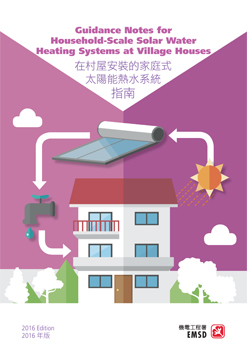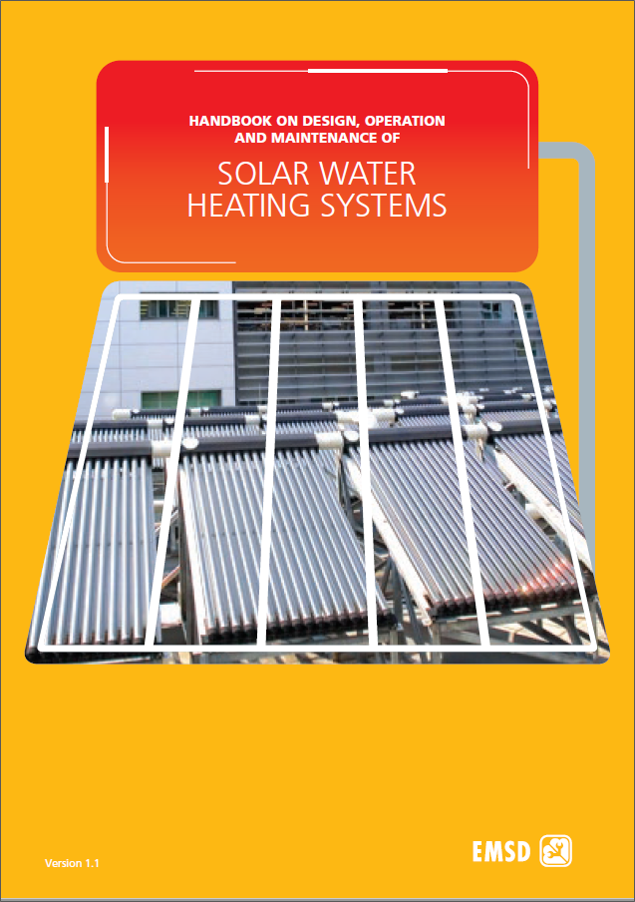Solar Water Heating
Application Considerations
General Procedure for Sizing a Solar Water Heating System
Step 1: Determining required capacity
Where the hot water demand can be measured, it is ideal to size the SWH system based on measured demands. In the case that the hot water demand cannot be measured, for example, in a new building, it should be based on an engineering estimation.
For the estimation of the daily hot water consumption of a building, one can make reference to some international design standards such as the Chartered Institute of Building Services Engineers (CIBSE) Guide B or Plumbing Engineering Services Design Guide published by the Institute of Plumbing and Heating Engineering. The daily heat requirement, Qhw, can be calculated according to the following equation:
| Qhw = Vhc x Cw x Dq | |
| Where |
Qhw = Daily heat requirement (MJ) Vhc = Average daily hot water consumption (m3) Cw = Specific volumetric heat capacity of water (=4.2MJ/m3/degree Celsius) Dq = Temperature difference between incoming water and the required hot water temperature (degree Celsius) |
(Average temperature of incoming water can be assumed to be 18 degrees Celsius winter months and 25 degrees Celsius in summer months whereas the hot water temperature for bathing can be assumed to be about 40 degrees Celsius)
The calculation is performed for each month of the year.
Step 2: Selection and sizing of solar collectors
The most common types of solar collectors are flat-plate and evacuated-tube. Compared to the flat-plate type collector, evacuated-tube collector is generally more expensive due to the more complex manufacturing process. However, it is more effective than flat-plate collector and requires a smaller installed area.
There are two important parameters to size solar collector surface area namely the solar irradiation and average system efficiency. Solar irradiation data of Hong Kong is available from the Hong Kong Observatory. The data for the daily mean horizontal solar irradiation for each month of the year is given in the Solar Water Heating - Resource Potential section.
System efficiency depends on various factors such as type and tilt angle of solar collectors, insulation of pipes and storage tank, shading effect of nearby buildings or plants, etc. Since all these factors cannot be fully evaluated at the design stage, it is common to adopt an estimate of the system efficiency, based on the designer's assumptions. Some overseas studies suggest the average system efficiency for a well-designed and well-installed SWH system is about 30% to 40% for flat-plate collectors, and about 40% to 45% for evacuated tube collectors.
The required collector surface area, ASC, can be estimated by the following equation:
| Asc = Qhw / (Eg x Hsys) | |
|
Asc = collector surface area (m2) Qhw = daily heat requirement (MJ) Eg = daily mean horizontal solar irradiation for the month (MJ/m2/day) Hsys = average system efficiency |
If the solar collectors are tilted, the Eg figure have to be adjusted by the appropriate tilt factor.
The above calculation is performed for each month of the year, From the twelve values of Asc obtained, choose a final Asc taking into account the various constraints.
Due to various considerations such as the budgetary and/or site limitations, it is quite often that the SWH system of a building will only be designed to meet a certain proportion of its hot water demand.
"Solar fraction" is equal to (MJ produced by the SWH system) divided by (MJ demand), and can be calculated for each month of the year and for the whole year.
Step 3: Designing the rest of the system
The simplest way is to size the storage tank according to the daily demand of hot water. As solar energy can only satisfy a portion of the water heating requirements, an auxiliary heater will normally be installed to raise the water temperature to meet operational requirements.
By taking into account the timing differences between the daily water draw-off pattern and the solar hot water production pattern, the size of the storage tank can be suitably reduced.
The configuration of the system (direct type, indirect type, etc.) can then be decided.
Step 4: Calculating energy yield and cost saving
Using solar energy to generate hot water will avoid the use of the same amount of energy required by a conventional gas or electrical heater in heating up the water. Therefore, the annual energy saving from a SWH system can be estimated by calculating the amount of solar energy absorbed by the SWH system, and then calculating the avoided cost of generating the same amount of heating energy using electricity or gas.
Step 5: Using computer software to carry out a detailed analysis
The calculation method presented above provide a quick estimation on the required solar collector areas and approximate annual cost saving. For more precise energy analysis, computer-modeling technique can be employed to simulate the performance of the SWH system.
Shading Analysis
Shading may be caused by trees and buildings in the surrounding and it will reduce the performance of solar water heating systems. Therefore, shading analysis should be performed if shading is considered likely to occur. Shading analysis can be performed with the aid of a sun path diagram or computer software to obtain the extent and duration of shading, and the effect on the overall performance of the system.
Software for Design and Evaluation of Solar Water Heating System
The This web page has hyperlinks which may transfer you to third-party website.RETScreen International Clean Energy Project Analysis Software is a decision support tool developed with the contribution of experts from government, industry, and academia in Canada. The software can be downloaded free-of-charge. The RETScreen Solar Water Heating Project Model can be used to evaluate the energy production, life-cycle costs and greenhouse gas emissions reduction for domestic hot water, ranging in size from small residential systems to large scale commercial, institutional and industrial systems.
This web page has hyperlinks which may transfer you to third-party website.TRNSYS is a transient systems simulation program with a modular structure, developed at the University of Wisconsin. The software is available for purchase from several distributors over the world. Using a system description language, the user can specify the components that constitute the system and the manner in which they are connected. The TRNSYS library includes many of the components commonly found in thermal and electrical energy systems, as well as component routines to handle input of weather data or other time-dependent forcing functions and output of simulation results. Main applications include: solar systems (solar thermal and photovoltaic systems), low energy buildings and HVAC systems, renewable energy systems, cogeneration, fuel cells.
There are also many other commercial software available. Users should study the capabilities of each piece of software to determine whether it can satisfy their needs.
Issues to be Considered When Installing Solar Water Heating System
Solar collector orientation
Solar collectors need to be located where plenty of sunshine strikes its surface. Solar collectors can be mounted from horizontal to an inclined angle. To maximize the amount of solar energy that solar collectors can receive over the course of a year, they should ideally be tilted at an angle equal to the latitude of the location (around 22 degrees for Hong Kong ) towards the south. It is also necessary to avoid any obstructions such as buildings or trees etc. that could prevent solar collectors from getting adequate exposure to solar radiation.
Retrofitting of solar water heating system
Retrofitting solar water heating system in premises which already employed centralised storage type water heating system are usually more straightforward as the existing plumbing pipe work and storage tank can be utilised.
Employ experienced designer and installer to carry out system design and installation work.
Market availability
There are plenty of solar thermal technologies products available in the market. Solar thermal products sold in Hong Kong are either imported from overseas countries such as Australia, Israel, USA or from the Mainland. Since there are many products available in the local market, prices are becoming competitive in recent years.
Maintenance and expected life
The maintenance requirements for solar water heating system vary depending on the system configuration. In general, solar thermal collectors have no moving parts and the maintenance requirements are very simple. A well-constructed, properly maintained system should last 20 to 25 years or more.
Guidance Notes for Household-scale Solar Water Heating System at Village Houses
Published by the Electrical and Mechanical Services Department, the "Guidance Notes for Household-scale Solar Water Heating System at Village Houses" provides general guidelines for the intending purchasers, owners and installers of household-scale solar water heating system installed at village houses to understand the installation requirements and application procedures associated with the installation, operation and maintenance of such solar water heating system.

Handbook on Design, Operation and Maintenance of Solar Water Heating Systems
The Handbook on Design, Operation and Maintenance of Solar Water Heating Systems provides recommendations on the best system design and operational practices in principle for solar water heating systems.
Please click here to read/download the booklet.
